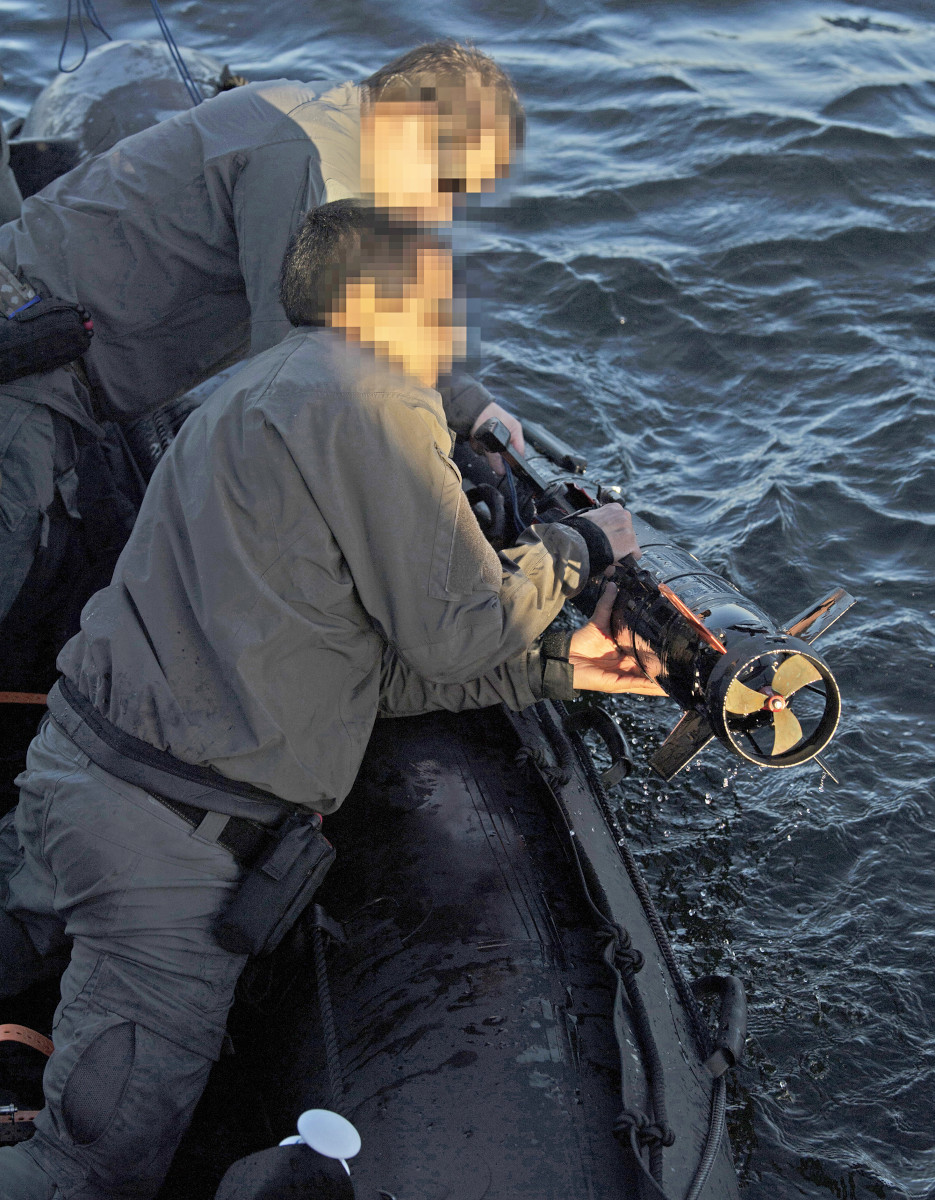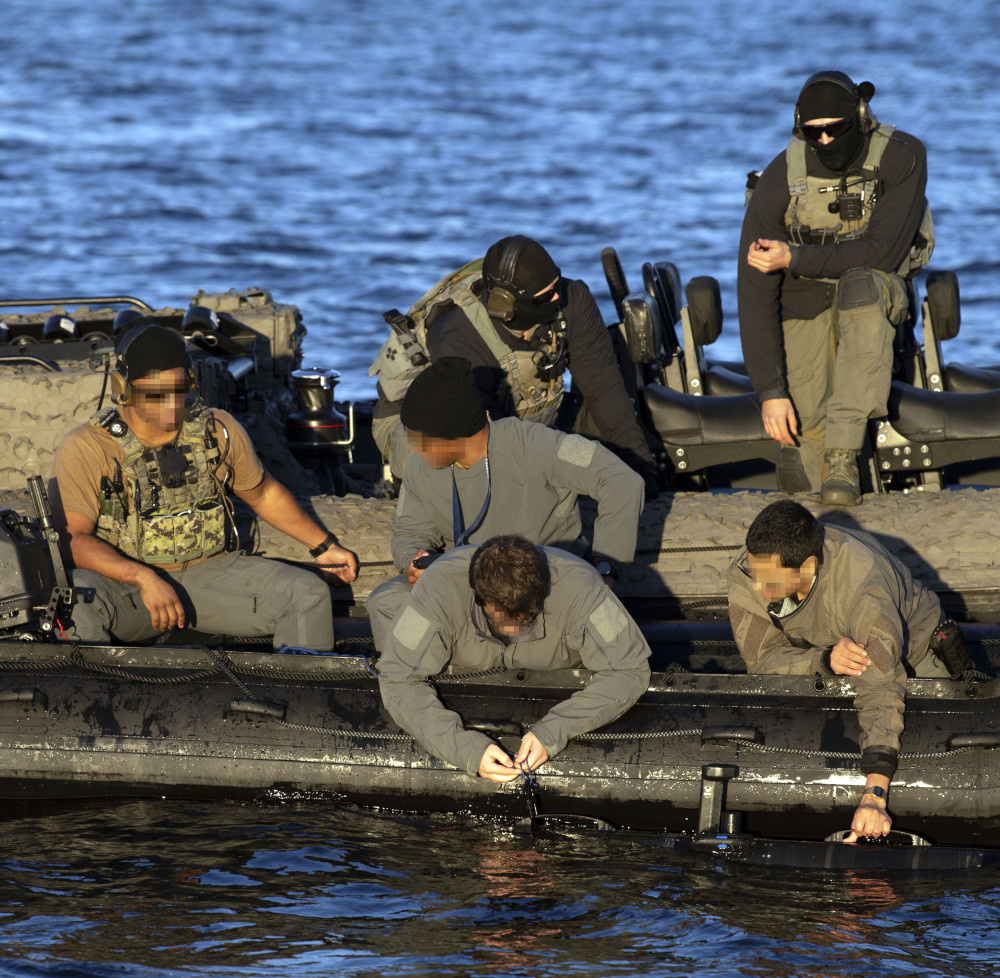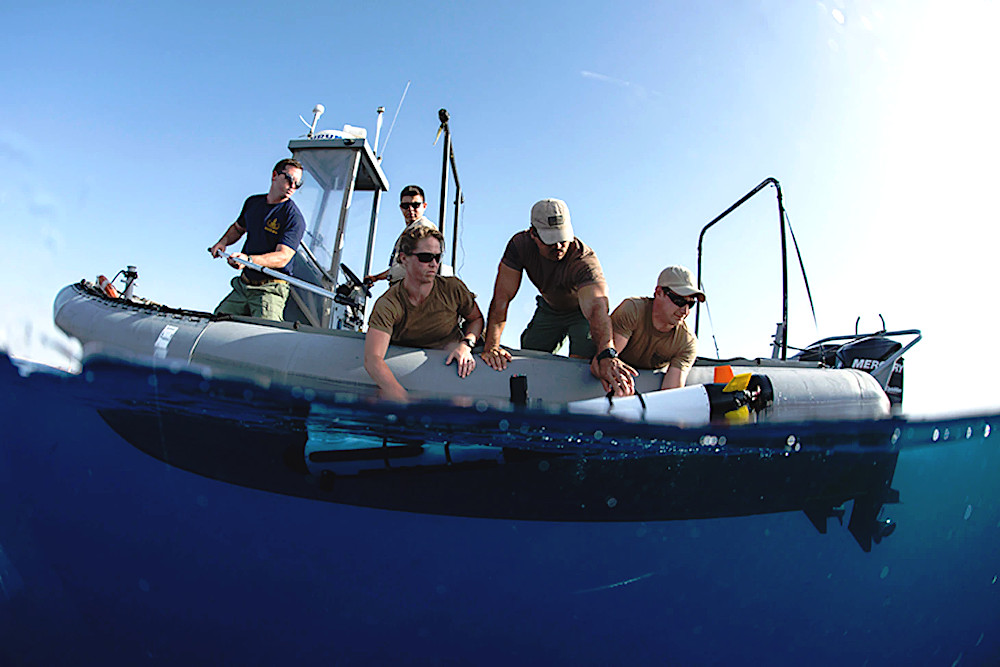U.S. special operators recently participated in an exercise in Sweden with members of that country’s armed forces and Home Guard, which involved a variety of assets in the air, on the ground, and at sea. This included the deployment and recovery of an unmanned underwater vehicle from a small Zodiak that itself was deployed by one of the U.S. Navy’s stealthy Combatant Craft Medium special operations boats. The drone enables maritime special operations forces to scout out areas to safely come ashore, hunt for mines and other hazards, and otherwise collect important data about what’s going on underneath the waves.
U.S. Special Operations Command Europe (SOCEUR) did not say where the various components of the exercise took place specifically, but the maritime portion involved training in the Baltic Sea near the Swedish city of Karlskrona on Nov. 6, 2020. In addition to the underwater drone, which is a member of the Iver family, and the Combatant Craft Medium (CCM), Swedish Navy Visby class stealth corvettes, as well as the support ship HSwMS Trosso and various other smaller watercraft, also took part.

There was also an air assault component to the training that involved U.S. Air Force CV-22B Osprey tilt-rotor, MC-130J Commando II special operations tanker-transport aircraft, and F-15E Strike Eagle combat jets, as well as Swedish Air Force Gripen fighters and C-130 Hercules transport planes. The MC-130Js and F-15Es may have been from contingents that deployed to Denmark earlier this month as part of a separate exercise in the Baltic region that also included Dutch, Danish, and Belgian forces.
“This exercise provides the opportunity to train with SOF [special operations forces] partners, as well as U.S. and Swedish conventional forces across all warfighting functions and domains. This allows us to train how we will fight, while also highlighting the credibility and capability of our combined forces,” Air Force Nathan Owendoff, head of the 352nd Special Operations Wing based in the United Kingdom and the commander of the Joint Special Operations Task Force that went to Sweden for the exercise, said in a statement. “The additive benefit is the critical value of building trust and strengthening relationships between commanders, element leaders, and special operations forces across multiple echelons.”

When it comes to training like you fight, the Baltic is an extremely important area for U.S. special operations and conventional forces to train in. It is a relatively small, but immensely strategic body of water that would be highly contested in any major conflict in the region, especially by Russia, for which it is a critical route between its warm water ports at one end and the North Sea at the other.
Special operations forces on both sides of such a conflict could be called upon to conduct raids on small islands and critical coastal infrastructure, search for potential hazards ahead of larger, conventional forces, and otherwise perform various reconnaissance and intelligence gathering missions. Stealthy special operations boats, such as the Navy’s CCMs, would be important tools to support any of those activities, but the use of underwater drones, such as the Ivers, would offer additional, more discreet means of doing so, especially in areas where the exact location and composition of enemy defenders might not be entirely clear.
We don’t know the exact configuration of the Iver that Navy special operators employed during the recent exercise in Sweden, but it appears to be an Iver3-series type, one of the latest generations of the design. OceanServer, now a division of L3Harris, introduced its first Iver models more than 15 years ago.
The torpedo-shaped unmanned underwater vehicle (UUV), which has a single shrouded propeller at the rear, is made up of modular sections that make it easier to tailor its capabilities to a user’s specific mission requirements. OceanServer’s website says that Iver3s are typically between six and seven feet long and are generally under 100 pounds, depending on the configuration. The weight and other factors also impact its endurance, which the company says is between eight and 14 hours with the drone cruising along at around two and a half knots.

The Navy says that the primary mission of its Iver-series drones is “battlespace awareness” and “intelligence preparation of the environment,” that is to say finding out what’s going on underneath the waves around a particular area or objective and gathering information that could help in the planning for upcoming operations, respectively. To support these missions, the undersea drones are typically equipped with side-scan sonar that can generate images of the seafloor and anything that might be sitting down there, for underwater mapping and survey purposes. They also have bathymetric sensors that can collect depth data that is also used to help create underwater maps.
The video below shows side-scan sonar images taken using an earlier Iver2 UUV, which offers a look at the kind of general capabilities the improved Iver3s provide to the Navy.

The drones can navigate semi-autonomously along a predefined route on the surface using passive sonar, or underwater, at depths down to 300 feet, using a depth sensor and corrected compass combined with something known as a Doppler Velocity Log (DVL). DVL provides an estimate of the drone’s velocity in relation to the sea bottom as determined by the depth sensor. With the heading from the compass, the UUV’s onboard systems can determine its position and steer it along the desired path.
The Iver3’s standard method of communicating with its operators is wireless Ethernet, via an antenna on a small mast. OceanServer also offers Iridium satellite communications and acoustic communications links for these UUVs.

For Navy special operations forces, as well as conventional units, UUVs such as the Iver-series can help provide a valuable understanding of what the ocean floor below looks like and what else might be down there, including hazards ranging from mines to purpose-built obstacles to innocuous debris or even just large rocks. Having this information would be especially useful for naval special operators planning to infiltrate into a particular area, either above the water in small watercraft or below in miniature submarines or using various kinds of personal diving equipment. They can also pass this critical data along to conventional forces planning larger-scale amphibious operations.
Using an unmanned platform also means that Navy personnel do not have to be as directly involved in these activities, allowing this information to be collected in a manner that limits their vulnerability to enemy forces. Relatively small underwater drones are also more difficult for an opponent to detect and allows for more discreet operations that could be particularly important to special operations forces operating in denied areas.
Conventional Navy forces also employ Ivers as part of more traditional mine-hunting operations, as well as explosive ordnance disposal duties, including routine sweeps of ports for potential hazards, including those that a hostile actor may have emplaced covertly. In 2017, Unmanned Undersea Vehicle Squadron One (UUVRON 1), the service’s first dedicated underwater drone unit, sent three Ivers, as well as a larger Bluefin 12D UUV, to join the search for the lost Argentinian Navy submarine ARA San Juan. The wreckage of that boat, which reportedly suffered a battery fire days before it sank and imploded, was finally found in November 2018.

It’s not clear whether the Iver3s that the Navy’s special operations community uses may have additional intelligence, surveillance, and reconnaissance (ISR) sensors or other capabilities. In 2010, Naval Special Warfare Command did acquire two smaller, earlier generation Iver2-series UUVs with multi-beam imaging sonar, in addition to the standard side-scan sonar.
It is interesting to note that the captions of the pictures showing the Navy special operators using the Iver in Sweden identify them as “Special Reconnaissance Unmanned Underwater Vehicle (UUV) operators,” further underscoring this particular mission set. “Special reconnaissance” in U.S. special operations parlance typically refers to missions that take place in denied or otherwise sensitive areas.
In addition, in December 2014, the Naval Special Warfare Command, which oversees the Navy SEALs and the services other special operations units, renamed its Special Warfare Support Activities One and Two as Special Reconnaissance Teams One and Two. This was to “more accurately reflect the mission” of these units, which is to “conduct preparation of the environment, intelligence, surveillance and reconnaissance, special operations, and combat support for supported commanders, inter-agency and host nation partners.” It seems very likely that the UUV operators the Navy sent to Sweden were from one of these two teams.
OceanServer also now offers an improved Iver4 series, the first model of which was the Iver4 900, with a standard length of just over eight feet and a weight of up to 230 pounds, depending on the configuration. In June, the company unveiled a smaller Iver4 580, similar size-wise to the earlier Iver3s, but various improvements carried over from the larger UUV, including GPS-assisted navigation on the surface and an inertial navigation system (INS) coupled with DVL for underwater operations.
The Iver4 580 is also faster than the Iver3s, able to cruise at up to four knots, or make dashes at up to five knots, depending on their configuration. Improved battery modules, which are also hot-swappable in the field without special tools, enable the drones to sail for up to 36 hours, giving them serious standoff and loitering capability.

In January, OceanServer announced that the Pentagon’s Defense Innovation Unit (DIU) had purchased an Iver4 900, as well as various associated equipment, on behalf of the Navy to support work on that service’s Next Generation Small-Class Maritime Expeditionary Mine Countermeasures Unmanned Undersea Vehicle (MEMUUV) program. This prototype system will be able to “detect, classify, localize, and identify targets on the ocean floor and in the water column [suspended underwater]” using sensors including “real aperture and synthetic aperture sonars,” according to a company press release.
The improved capabilities that the Iver4 900 and 580 models offer certainly seem like that would be broadly attractive to the Navy for various conventional and special operations missions beyond just mine-hunting, in the same vein as its existing Iver types.
The broad benefits that special operators, as well as conventional forces, get from having access to these kinds of small, lightweight, but increasingly capable UUVs were certainly on display during the recent exercise in Sweden. It underscores how unmanned systems are only becoming more and more ubiquitous in military operations at sea, as well as in the air and on land, a trend this is showing no signs of slowing down.
Contact the author: joe@thedrive.com
———
